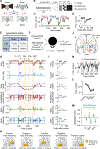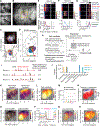Shared and specialized coding across posterior cortical areas for dynamic navigation decisions
- PMID: 35679861
- PMCID: PMC9357051
- DOI: 10.1016/j.neuron.2022.05.012
Shared and specialized coding across posterior cortical areas for dynamic navigation decisions
Abstract
Animals adaptively integrate sensation, planning, and action to navigate toward goal locations in ever-changing environments, but the functional organization of cortex supporting these processes remains unclear. We characterized encoding in approximately 90,000 neurons across the mouse posterior cortex during a virtual navigation task with rule switching. The encoding of task and behavioral variables was highly distributed across cortical areas but differed in magnitude, resulting in three spatial gradients for visual cue, spatial position plus dynamics of choice formation, and locomotion, with peaks respectively in visual, retrosplenial, and parietal cortices. Surprisingly, the conjunctive encoding of these variables in single neurons was similar throughout the posterior cortex, creating high-dimensional representations in all areas instead of revealing computations specialized for each area. We propose that, for guiding navigation decisions, the posterior cortex operates in parallel rather than hierarchically, and collectively generates a state representation of the behavior and environment, with each area specialized in handling distinct information modalities.
Keywords: calcium imaging; conjunctive coding; cortical organization; decision-making; navigation; parietal cortex; population coding; representational geometry; retrosplenial cortex; virtual reality.
Copyright © 2022 The Author(s). Published by Elsevier Inc. All rights reserved.
Conflict of interest statement
Declaration of interests The authors declare no competing interests.
Figures








Comment in
-
Everything, everywhere, all at once: Functional specialization and distributed coding in the cerebral cortex.Neuron. 2022 Aug 3;110(15):2361-2362. doi: 10.1016/j.neuron.2022.07.006. Neuron. 2022. PMID: 35926451
Similar articles
-
A distributed and efficient population code of mixed selectivity neurons for flexible navigation decisions.Nat Commun. 2023 Apr 14;14(1):2121. doi: 10.1038/s41467-023-37804-2. Nat Commun. 2023. PMID: 37055431 Free PMC article.
-
The Spatial Structure of Neural Encoding in Mouse Posterior Cortex during Navigation.Neuron. 2019 Apr 3;102(1):232-248.e11. doi: 10.1016/j.neuron.2019.01.029. Epub 2019 Feb 13. Neuron. 2019. PMID: 30772081 Free PMC article.
-
Conjunctive processing of spatial border and locomotion in retrosplenial cortex during spatial navigation.J Physiol. 2024 Oct;602(19):5017-5038. doi: 10.1113/JP286434. Epub 2024 Aug 31. J Physiol. 2024. PMID: 39216077
-
The retrosplenial-parietal network and reference frame coordination for spatial navigation.Behav Neurosci. 2018 Oct;132(5):416-429. doi: 10.1037/bne0000260. Epub 2018 Aug 9. Behav Neurosci. 2018. PMID: 30091619 Free PMC article. Review.
-
From visual affordances in monkey parietal cortex to hippocampo-parietal interactions underlying rat navigation.Philos Trans R Soc Lond B Biol Sci. 1997 Oct 29;352(1360):1429-36. doi: 10.1098/rstb.1997.0129. Philos Trans R Soc Lond B Biol Sci. 1997. PMID: 9368931 Free PMC article. Review.
Cited by
-
Geometric transformation of cognitive maps for generalization across hippocampal-prefrontal circuits.Cell Rep. 2023 Mar 28;42(3):112246. doi: 10.1016/j.celrep.2023.112246. Epub 2023 Mar 15. Cell Rep. 2023. PMID: 36924498 Free PMC article.
-
An entorhinal-like region in food-caching birds.Curr Biol. 2023 Jun 19;33(12):2465-2477.e7. doi: 10.1016/j.cub.2023.05.031. Epub 2023 Jun 8. Curr Biol. 2023. PMID: 37295426 Free PMC article.
-
An entorhinal-like region in food-caching birds.bioRxiv [Preprint]. 2023 Jan 6:2023.01.05.522940. doi: 10.1101/2023.01.05.522940. bioRxiv. 2023. Update in: Curr Biol. 2023 Jun 19;33(12):2465-2477.e7. doi: 10.1016/j.cub.2023.05.031. PMID: 36711539 Free PMC article. Updated. Preprint.
-
Mixtures of strategies underlie rodent behavior during reversal learning.PLoS Comput Biol. 2023 Sep 14;19(9):e1011430. doi: 10.1371/journal.pcbi.1011430. eCollection 2023 Sep. PLoS Comput Biol. 2023. PMID: 37708113 Free PMC article.
-
A distributed and efficient population code of mixed selectivity neurons for flexible navigation decisions.Nat Commun. 2023 Apr 14;14(1):2121. doi: 10.1038/s41467-023-37804-2. Nat Commun. 2023. PMID: 37055431 Free PMC article.
References
-
- Abadi M, Agarwal A, Barham P, Brevdo E, Chen Z, Citro C, Corrado GS, Davis A, Dean J, Devin M, et al. (2016). TensorFlow: Large-Scale Machine Learning on Heterogeneous Distributed Systems. arXiv 10.48550/arXiv.1603.04467. - DOI
-
- Akrami A, Kopec CD, Diamond ME, and Brody CD (2018). Posterior parietal cortex represents sensory history and mediates its effects on behaviour. Nature 554, 368–372. - PubMed
-
- Alexander AS, and Nitz DA (2015). Retrosplenial cortex maps the conjunction of internal and external spaces. Nat. Neurosci 18, 1143–1151. - PubMed
-
- Alexander AS, and Nitz DA (2017). Spatially Periodic Activation Patterns of Retrosplenial Cortex Encode Route Sub-spaces and Distance Traveled. Curr. Biol 27, 1551–1560. - PubMed
Publication types
MeSH terms
Grants and funding
LinkOut - more resources
Full Text Sources
Molecular Biology Databases

